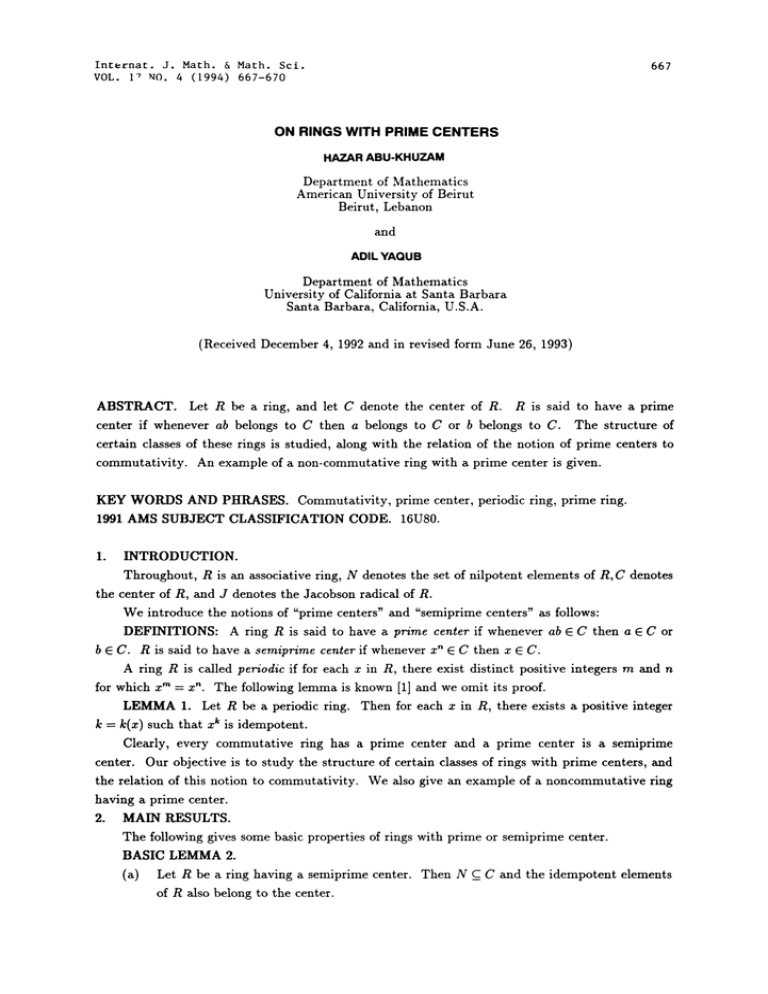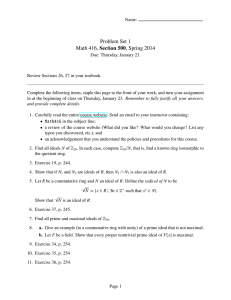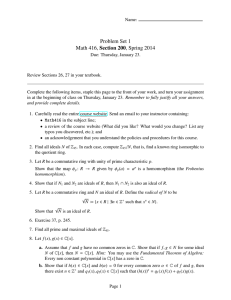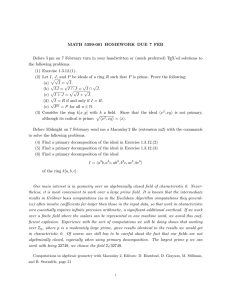CENTERS 1993) ON RINGS WITH PRIME Department
advertisement

Internat. J. Math. & Math. Sci.
VOL. IV NO. 4 (1994) 667-670
667
ON RINGS WITH PRIME CENTERS
HAZAR ABU-KHUZAM
Department of Mathematics
American University of Beirut
Beirut, Lebanon
and
ADIL YAQUB
Department of Mathematics
University of California at Santa Barbara
Santa Barbara, California, U.S.A.
(Received December 4, 1992 and in revised form June 26, 1993)
ABSTRACT. Let R be a ring, and let C denote the center of R. R is said to have a prime
center if whenever ab belongs to C then a belongs to C or b belongs to C. The structure of
certain classes of these rings is studied, along with the relation of the notion of prime centers to
commutativity. An example of a non-commutative ring with a prime center is given.
KEY WORDS AND PHRASES. Commutativity, prime center, periodic ring, prime ring.
1991 AMS SUBJECT CLASSIFICATION CODE. 16U80.
INTRODUCTION.
Throughout, R is an associative ring, N denotes the set of nilpotent elements of R, C denotes
the center of R, and J denotes the Jacobson radical of R.
We introduce the notions of "prime centers" and "semiprime centers" as follows"
DEFINITIONS: A ring R is said to have a prime center if whenever ab E C then a E C or
b C. R is said to have a seraiprime center if whenever x" C then x C.
A ring R is called periodic if for each x in R, there exist distinct positive integers m and n
for which x" x". The following lemma is known [1] and we omit its proof.
LEMMA 1. Let R be a periodic ring. Then for each x in R, there exists a positive integer
1.
k
k(x) such that x k is idempotent.
Clearly, every commutative ring has a prime center and a prime center is a semiprime
center. Our objective is to study the structure of certain classes of rings with prime centers, and
the relation of this notion to commutativity. We also give an example of a noncommutative ring
having a prime center.
2.
MAIN RESULTS.
The following gives some basic properties of rings with prime or semiprime center.
BASIC LEMMA 2.
(a) Let R be a ring having a semiprime center. Then N C_ C and the idempotent elements
of R also belong to the center.
668
H. ABU-ZHUZAM AND A. YAQUB
Let R be a ring with identity and having a prime center. Then the units of R are
central and hence J C C.
(c) Let R be a prime ring having a semiprime center. If e is an idempotent of R, then
e 0 or e
(if R has 1).
(d) Let {R,,i E F} be a family of rings. If the direct sum E "R, has a prime center, then
R, has a prime center for each E F. Moreover, at most one R, is noncommutative.
PROOF. (a) Let a be any nilpotent element in N. Then a k 0 for some positive integer k,
and hence a k C. This implies that a C since R has a semiprime center. So N _C C. Let e be
any idempotent element and z any element of R. Then, (ez- eze) N and hence
(b)
( )
( ).
This implies that ez eze. Similarly me eze, and hence e belongs to the center of R.
(b) Let u be any unit in R. Thenuu-l=l_C. This implies thatuECoru-lC, and
hence u C. If a J then a + is a unit, and hence central. So J C C.
(c) Let e be an idempotent element of R. By Lemma 2(a), e is a central idempotent and
hence
eR(ex- x)
_ _
_
0 for all x
R.
x for all x E
R.
This implies, since R is a prime ring, that
e
0 or ex
x for all x R. Since e C, therefore xe x for all x R also. Hence e 1.
Let C be the center of E "R, and C, be the center of R, for each
F. Let aj and bj
be two elements of Rj(j F) such that ajb C. Let {a,} and {b,} be two elements in the direct
sum E "R, such that
If e
# 0, then ex
(d)
EF
a,
Then
0 if
j
a if i= j,
{a,}-{b,}
_
{0b
b,
if
Tj
ifi=j"
7j
0
if
a,b,
if/=
j"
This implies that {a,}{b,} e C since a,b C, (the center of R). Hence {a,} C or {b,} e C
since
or b E
SO has a prime center for
"Ri has a prime center. Therefore, aj
iF
each j E F.
To complete the proof, suppose Ri and Rj are both noncommutative, # j. Let
a, R\C,,a Rj\C (where C, C denote the centers of R,R, respectively). Let
C
0
a
Then
{a}{b}
0
ifk#i and
ifk=i
b,
C.
R
0 ifk#j
aj ifk=j
e C while {a} C, {bk} C, contradiction.
We now proceed to prove the main theorems.
THEOREM 1. Let R be a periodic ring. Then R is commutative if and only if R has
semiprime center.
PROOF. If R is commutative, then R clearly has a semiprime center. Suppose that R has
a semiprime center and let x be any element of R. Since R is periodic, Lemma 1 implies that
RINGS WITH PRIME CENTERS
669
is idempotent for some positive integer k. Hence by Lemma 2(a), x’E C. This implies that
x E C, since R has a semiprime center.
THEOREM 2. Let R be a prime ring with a semiprime center. Then R is a domain.
PROOF. By Lemma 2(a), N C C. But the center of a prime ring has no nonzero zero
{0}. It is well known that a prime ring with g {0} is a domain.
THEOREM 3. Let R be an Artinian ring with prime center, and N the set of nilpotent
eIements. Then N is an ideal and is a direct sum of fields.
PROOF. By Lemma 2(a), N C_ C; and this implies that N is an ideal. Now is Artinian
is a (finite) direct sum of division
and reduced, so by the Wedderburn-Artin structure theory,
u + N be
rings. let R1 be a division ring which is an internal direct summand of and let
the identity element of R 1. Since idempotents may be lifted, there exists an idempotent e 6- R
such that
e + N. By Lemma 2(a), e C.
Let =x+N and =y+N be inverses in R1. Then =-e-, so xy=e+v for some
vN. Thusxy6-C, andhencexECoryC. Soy ory is central in R1. But if one is, so is
the other. Hence Ra is commutative, and thus R is a field. This proves the theorem.
COROLLARY 1. Let R be a prime Artinian ring with identity 1. If R has a prime center,
then R is a field.
PROOF. Let I be a nonzero ideal of R. Then I is non-nilpotent, since R is a prime ring.
This implies that I contains a nonzero idempotent element, since R is Artinian ([2], Theorem
I and hence I R. This implies that R is a simple ring. Hence,
1.3.2). So, by Lemma 2(c),
by Theorem 3, R is a field.
COROLLARY 2. Let R be a semisimple Artinian ring. If R is a prime center, then R is
divisors, and hence N
-
R
R
-
isomorphic to a direct sum of fields.
PROOF. This follows at once from Theorem 3, since N {0}.
THEOREM 4. Let R be a ring with identity and having a prime center. If for each x R,
there is a monic polynomial f fx with integer coefficients such that f(x)6.C, then R is
commutative.
PROOF. We will prove that if x R with fx(x) 6. C, then x E C. We proceed by induction
degree n of the polynomial fx. If n 1, then x 6. R with fx(x) x + ao 6. C. This implies
that x 6. C. Suppose that the above statement is true for all x 6. R having a polynomial f of
degree n with f(x) 6. C. Let y R with
on the
f (y) y’+ + a,y" +
where ao,-
.,a,
are integers. Thus
y, + 1.3f. a,y" +
and hence
y(y" + a,y"-
.
._
_
+ ay + ao6.C
+ aly 6. C,
a2y
+ a)
C.
If y it C, then y"+ a,y"- +
+ a 6. C since R has a prime center. So, y has a polynomial g
of degree n with g(y) C. Hence y C by the induction hypothesis. This completes the proof of
Theorem 4.
3. EXAMPLE OF A NONCOMMUTATIVE RING WITH A PRIME CENTER.
Choose F to be an infinite field admitting an automorphism a of infinite order. Let Fix, a]
670
H. )d3U-KHUZAH, AND A. YAQUB
be the skew polynomial ring of all polynomials p(x) over F such that x"a r"(a)z for every
a E F d every positive integer n. It is esy to verify that F[, ] is domain.
Let
F[,]. We will show that R is noncommuttive ring hving prime center.
Let C denote the center of nd let () a az
a be ny nonzero elenent in
it being ssumed that a O. Now,
the center of
,
+ xanx
() + () +... + () +
P(x)x al x2 + a2x3 +
+ a,,x +
xP(x)
d
xalx + xa2x
+
.
But xP(x)= P(x)x, since P(x) C. This implies that
,a(a,) a,.
a(a,) a,,a(a) a,
Since a h an infinite order, there exists an element a
(3.1)
F such that
(3.2)
NOW,
axP(x)
Also,
But axP(x)
axalx + axa2x
+
+ axa,x"
,(,1), + (,,) +
+ .o(.)- /,
3
by (3.1)
+ aa,x" +
aalx / aa2x +
P(x)ax a,xax + a2x2ax +
+ a,x"ax
,() + ,() +
+ () +,.
P(x)ax, since P(x) C. This implies that
aa
a,a(a),aa aa(a),
.,aa,
a,a"(a)
(3.3)
Since F is a field d a, # 0, the lt of these equations contradicts (3.2). Hence P(z) 0, d
the center C {0}. Thus, R F[z,]z is a domMn with center {0}. This implies that R h a
prime center. For, if P(z)q(z)6 C {0}, then P(z). q(z)= 0. This implies that P(z)= 0 6 C or
q(z) 0 C, since R is a domMn. R is clely a noncommutative ring (za ,(a)z # az).
ACKNOWLEDGEMENT. We would like to express our gratitude and indebtedness to the
referee for the helpful suggestions made, which resulted in improving the results of this paper.
,,.REFEREN(ES
1.
2.
BELL, H.E., Some commutative results for periodic rings, Acta. Math. Acad. Sci. Hungar.,
(96),
HERSTEIN, I.N., Noncommutative Rings, The Carus Math. Monographs, John Wiley and
Sons, Inc., 1968.








